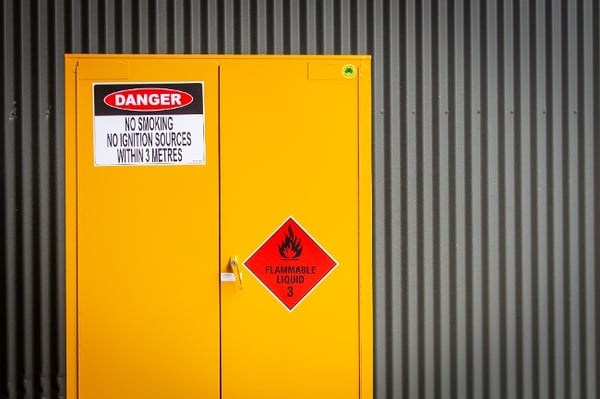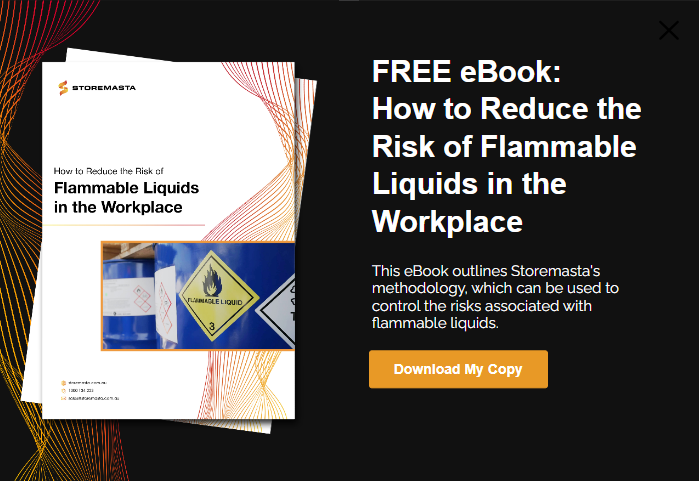How are your staff using your flammable liquids cabinet? Are they stacking and loading the cabinet in a safe and compliant manner? Whether you’ve just bought your first cabinet, or you’ve been using a flammable cabinet for years, a cabinet will only reduce risk if it’s used in the correct way. So, to help you maintain safety and compliance, we’ve compiled our top 5 do’s and don’ts for loading your flammable cabinet.
Do #1. Keep Lids on Containers
While it may seem like common sense that your chemical containers are secured with a lid, it’s important to understand the hazards associated with flammable liquids. It’s not only the risk of a chemical spill or leak from an open container, there is also the potential for flammable vapours to build-up within the Class 3 cabinet and escape into the workplace.
Class 3 Flammable Liquids emit vapours which can quickly ignite at room temperature. If vapours meet an ignition source, a fire or explosion will occur.
Managing the vapour levels within your flammable liquids stores is not only vital to reducing the risk of fire or explosion, but it’s also a requirement of the Workplace Exposure Standards.
Safe Work Australia introduced Workplace Exposure Standards to ensure businesses kept their air quality at a safe and healthy level. If your chemicals are listed in the Workplace Exposure Standards — and the vapours emitted are above the legal limit — then you’re putting the health and safety of your staff at risk. Your business could also face heavy penalties for allowing vapour levels to rise above the legal limits.
To assist with maintaining the correct concentration levels, you should always store your flammable liquids in closed containers (or containers fitted with a tap). It’s also a good practice to wipe down your containers after use, so you can return your chemicals to their cabinet without any residue remaining on the container.

To reduce the risk of fire, explosion or human harm, all flammable liquids should be stored in a closed container with a compliant Class 3 cabinet.
Do #2. Stack Drums Properly
If you’re storing drums of flammable liquids in your cabinet, stacking them in an organised way isn’t just easier for your staff – it also reduces the risk of chemical spills. When you have drums of 60 L or more, you must only stack them two high in your cabinet. Make sure that your drums have lids that are tightly secured and ensure they’re wiped down after use.
Do you need to store flammable liquid drums in a decanting position? To maintain compliance, you must only have one drum (60 L or more) in the horizontal decanting position within your flammable cabinet.
Do #3. Check For Spills
Your flammable liquids cabinet is specifically designed to direct any chemical leaks or spills to the lower spill compound. This liquid-tight sump has the capacity to contain flammable liquid spills if they occur.
However, if your sump is not cleaned after a spill or leak, it can result in a build-up of liquid chemicals and flammable vapours within your cabinet.
Issues include:
- Increased risk – the spilt liquids will emit vapours that can overwhelm staff when they access the cabinet. These vapours will also increase the risk of fire and explosion if they meet an ignition source.
- Compromised sump capacity – your cabinet won’t be able to contain chemical spills if the spill sump already is in use. This will put your business at risk of a serious chemical spill that will spread beyond your cabinet sump.
To avoid these chemical compliance issues, staff should always notify supervisors when a spill or leak occurs. Spills and leaks should be cleaned up as soon as possible, with precautions taken to dispose of the chemical waste, cleaning rags and other items in a safe manner.
Get your free spill prevention guide
Do #4. Keep Doors Closed
Your flammable cabinet is a great risk control measure – if it’s used and maintained in the right way. As it’s constructed from double-walled steel, your cabinet can provide some protection for your flammable chemicals in the event of a workplace fire, so staff can quickly evacuate.
Your cabinet will also contain flammable vapours — unless a mechanical ventilation system has been installed.
However, your cabinet can’t control the risk of fire or explosion if the doors of the cabinet are left open.
When staff are using a flammable cabinet, they should be instructed to shut the doors as soon as they have taken or returned the chemicals. Cabinet doors should never be propped open or held open by staff for excessive periods of time.
You should also train staff, supervisors and contractors to maintain the correct loading and stacking practices for your flammable cabinets to avoid the doors remaining ajar.
Remember, always store containers in a neat fashion within the cabinet — and make sure that they don’t interfere with the door closing mechanisms.
Do #5. Eliminate Combustibles
When flammable liquids ignite, they will quickly consume any combustible materials that may be present in your workplace. By allowing ‘fuel’ for the fire to build-up in your workplace, you’re increasing the risk of fire or explosion. A key safety measure for loading your flammable cabinet, is to ensure that any combustible materials are not stored in your cabinet. This may include combustibles such as excess packing, paper files, paintbrushes and cleaning rags.
Never store anything but Class 3 Flammable Liquids in your cabinet — and prohibit staff from leaving items on top of your cabinet.
REMEMBER: For a full list of requirements relating to flammable liquids safety, see the Australian Standard 1940 for all storage and handling guidelines. See below for a list of DON'TS for your flammable liquid cabinet and ensure safety at your site!
Don't #1. Store Incompatible Substances
The only thing that should be stored in a flammable cabinet are Class 3 Flammable Liquids. With 9 different classes, there are many incompatible substances that can violently react if they are placed near flammable liquids.
These include:
- Class 1 Explosives
- Class 2 Gases (with the exception of aerosols)
- Class 4 Flammable solids
- Class 5.1 Oxidizing Agents
- Class 5.2 Organic peroxides
- Class 6 Toxic substances
- Class 8 Corrosive substances
These chemicals are incompatible with flammable liquids and should never store in your cabinet. Each class of chemical in your business should be stored in a safety cabinet that’s been designed and constructed to meet the specific safety requirements of that Dangerous Goods class.
Don't #2. Store Anything in Spill Sump
When you purchase a flammable cabinet (or any safety cabinet for that matter), it’s important that you’re buying a cabinet that has an adequate maximum storage capacity. Overloading your cabinet is a dangerous practice that can increase risk for your business. With that being said, your cabinet should comfortably contain your Class 3 Flammable Liquids. Therefore, you should never be storing your flammable liquids in the spill containment sump.
This sump is a risk control measure that is specifically designed to contain chemical spills. If you’re storing chemical containers in your sump, you’re probably also overloading your cabinet — and prohibiting the spill sump from containing any possible chemical spills or leaks.
Don't #3. Overload Your Cabinet
As we’ve just touched on, overloading your cabinet past its maximum capacity is a dangerous and non-compliant practice.
Your cabinet can only provide superior protection for the people and property of your business if it’s loaded in the correct manner. And one of the most important things to remember when loading your cabinet, is to ensure you don’t exceed the maximum load capacity.
Overloading a cabinet will increase risk for your business and negate the safety features of the cabinet, such as providing a fire barrier, vapour containment and chemical spill containment.
If you’re in doubt about how many litres your flammable cabinet can hold, simply check the pre-installed sign on the front of your cabinet for the equipment’s maximum load capacity.
Only use the shelves of the cabinet for storage and don’t overload past its maximum storage capacity.
Don't #4. Include Ignition Sources
Mixing an ignition source with a flammable liquid store is a recipe for disaster. As highly volatile substances with a low flash point, flammable liquids have the capability to easily ignite. Flammable liquid fires are a particularly dangerous type of fire, as they spread quickly, emit toxic fumes and burn fiercely before intensifying.
Therefore, no ignition source – whether it’s chemical, mechanical, electrical or thermal — should ever be stored within a cabinet. In fact, ignition sources (such as power points, pilot lights, welding equipment etc) should not come within 3 m of a flammable cabinet. Any failure to do so will cause your flammable liquids to ignite.
It’s crucial that all staff and contractors are properly trained in flammable liquids safety. This will reduce the risk of personnel bringing an ignition source within 3m of your flammable liquid stores.
Don't #5. Let Untrained Staff Use Cabinet
Flammable liquids safety is a serious and complex matter. Class 3 liquids can include hazardous substances such as petrol, acetone, ethanol, kerosene and paint thinners.
Therefore, any staff member or contractor that works with Class 3 Dangerous Goods should always receive thorough training on how to correctly handle and store these hazardous chemicals. Your cabinet is only effective in chemical risk reduction if your staff understand how to use and maintain it in a safe and compliant manner.
Training should cover a vast range of topics, including:
- Correct installation process
- General use and features of the cabinet
- Cabinet housekeeping and maintenance procedures
- Chemical class identification through Safety Data Sheets
- The dangers of incompatible substances
- Identification and elimination of ignition sources
- How to load and stack the cabinet
- How to clean out the spill sump correctly
- The hazards associated with combustibles
- How to reduce risk of fire and explosion
- What to do if chemicals come into contact with the face or body
- Emergency procedures including evacuation
- Prohibited activities in the work area of the cabinet
How Is Your Flammable Cabinet Loaded?
If you want to safeguard your business and community against the dangerous of flammable liquids, you must understand how to correctly load your flammable cabinet. Flammable storage cabinets that are manufactured in full conformance with AS 1940 are the only cabinets which should be used to store Class 3 Flammable Liquids. To find out more about reducing chemical risk in your organisation, why not download our eBook? How To Reduce The Risk Of Flammable Liquids In The Workplace will introduce you to our 4-step risk control methodology that can be easily applied to your own organisation. Get your copy for free today.

Living life by the 4 C’s of marketing – communication, coffee, compliance… and more coffee – Leisa Andersen is Storemasta’s Content Marketing Manager. When she’s not writing, you’ll find her enjoying all the good things in life, including shopping, travel and gluten free donuts.



